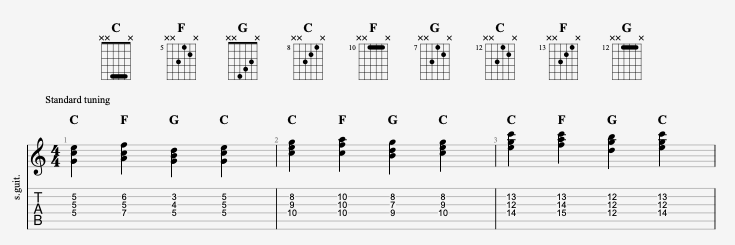Guitar Practice: Triads and Melody
Triads are chords in their simplest form.
You might think that the “box” forms you learned early on are the simplest ones, but any major or minor chord only requires three notes. When a beginner learns a C chord on piano, it’s almost always introduced as a triad: C-E-G, with the right thumb on middle C. The standard open position C chord contains 5 notes, two of them doubled: C – E – G – C- E.
Taking a closer look, you might notice how this big chord contains three overlapping versions of the C triad:
(Be sure to look at the notation too, not just the tab. Even if you don’t read music, it helps to see the movement of the individual notes).
The three triads all contain the same notes in 3 different orders, but always in sequence (low to high): C-E-G, E-G-C, and G-C-E. Each triad lives on its own set of three adjacent strings. The diagrams distinguish the names by the bass note, but it would be equally correct to call them all C chords.
Without going too deep into the math, let’s just say for now that we can build a triad by starting with a root and then skipping a letter twice: C to E to G. In the key of C, we don’t need to include any sharps or flats:
C D E F G A B C
The C triad is formed by the first, third, and fifth notes of the C major scale.
If we apply this formula using each of the seven tones as a root, we get a set of seven diatonic triads:
C major: C E G
D minor: D F A
E minor: E G B
F major: F A C
G major: G B D
A minor: A C E
B diminished: B D F
“Diatonic” means that we pull the notes directly from the source scale or C. This creates a sequence of chord qualities, major, minor, or diminished. This is a topic worthy of its own article and much more. For now, we’re just going to work with three major triads: C, F, and G.
When our hypothetical piano student first encounters a G chord, it might appear like this. The root position G triad is spelled G-B-D, but notice that here B is the lowest note. This is an example of voice-leading: keeping the tones of each chord as close together as possible.
The G chord is spelled G-B-D. So why introduce it with B as the lowest note? This is an example of voice-leading triads: keeping the tones of each chord as close together as possible.
When we string chords together, each note is like a voice in a choir.
If we keep all the chords in root position, it looks and sounds like this:
There’s nothing wrong with the way it sounds. But you can see how the entire triad jumps up or down, with all three voices moving together. Looking back at the first example, you can see and hear how the notes stay closer together. The G note, root of the G triad, is on top because it’s a common or shared tone with the G note in the C triad. The other two voices drop to the next scale tone:
string 1: G —- G —- G
string 2: E —> D —> E
string 3: C —> B —> C
Voice leading allows you to make chord changes more melodic.
Many great classic rock riffs are memorable for their melodic use of triads: listen to “Panama” by Van Halen, “Free Ride” by Edgar Winter, “Run Like Hell” by Pink Floyd, “Turn It On Again” by Genesis, or “The Wind Cries Mary” by Jimi Hendrix. Besides being fun, learning familiar songs gives you examples of how triads are used on guitar. But it’s also really helpful to do drills that make you think through the shapes you’ve learned.
For example, this exercise walks through C-F-G-C using three triad forms on the same string set. Practice this slowly, out of time, concentrating on the voice-leading. Notice how each string forms its own melody, and listen for each one.
Mixing these up gives us different melodies on each string, but all the chord changes remain fluid.
Your ultimate goal is to be able to play any triad in any position on any string set, but don’t try to memorize everything at once! This exercise uses just three shapes, and puts them in a musical context. Use this as a model and try the same chord sequence in another key. Or put the same chords in a different order. Even if your goal is simply to play your favorite songs, exercises like this help you do that by reinforcing how well you know your way around your guitar.
Interested in learning to solo on guitar? Check out JamPlay.com. JamPlay has over 450 guitar courses from 120+ instructors, and online guitar lessons tailored to every skill level, music genre, and playing style. Click here to learn more.
Dave Isaacs has established himself as a guitar teacher extraordinaire, having built a strong set of educational curriculums for beginner, intermediate, and advanced guitar players alike. Dave shares his expertise largely through video platforms, but also through his thoughtful writing. You can take guitar lessons from Dave Isaacs via his comprehensive video guitar courses on JamPlay.com.
Share this
Become a JamPlay member for unlimited access to 7000+ guitar lessons and 120+ artists and instructors. View membership plans ›










